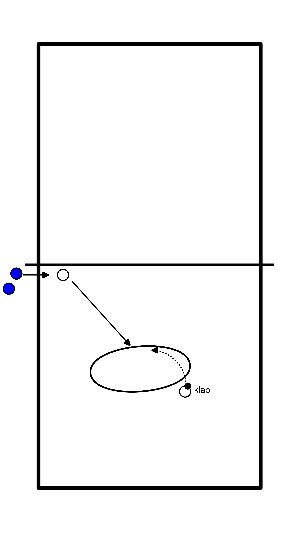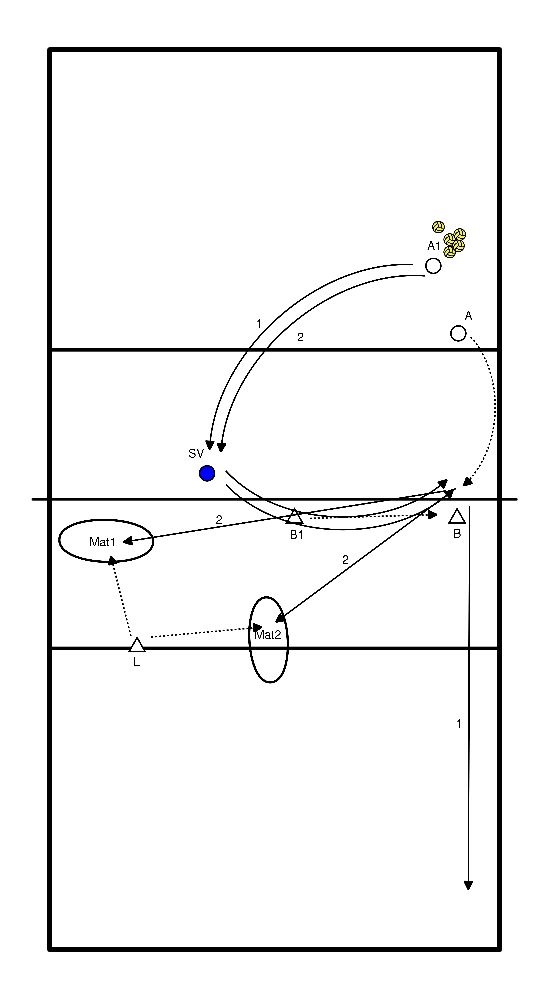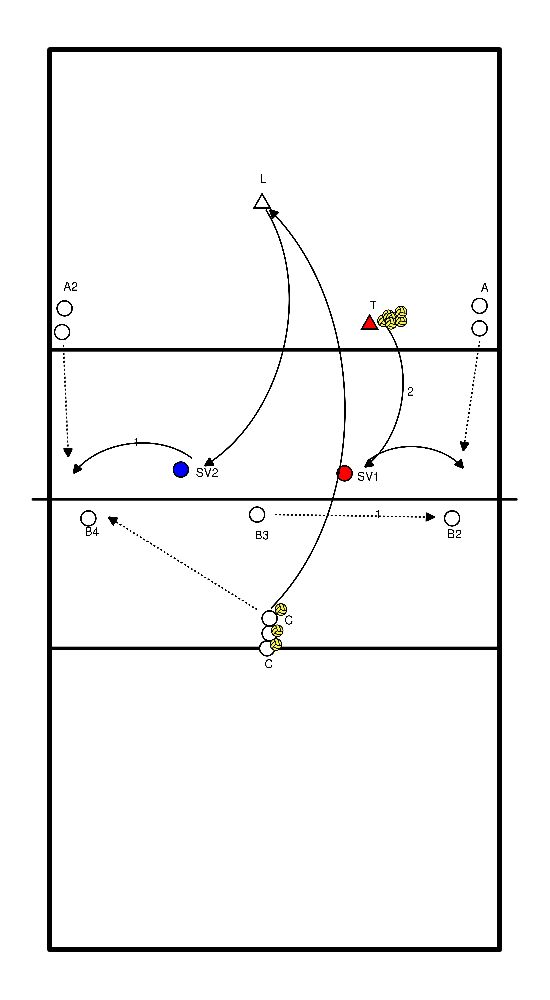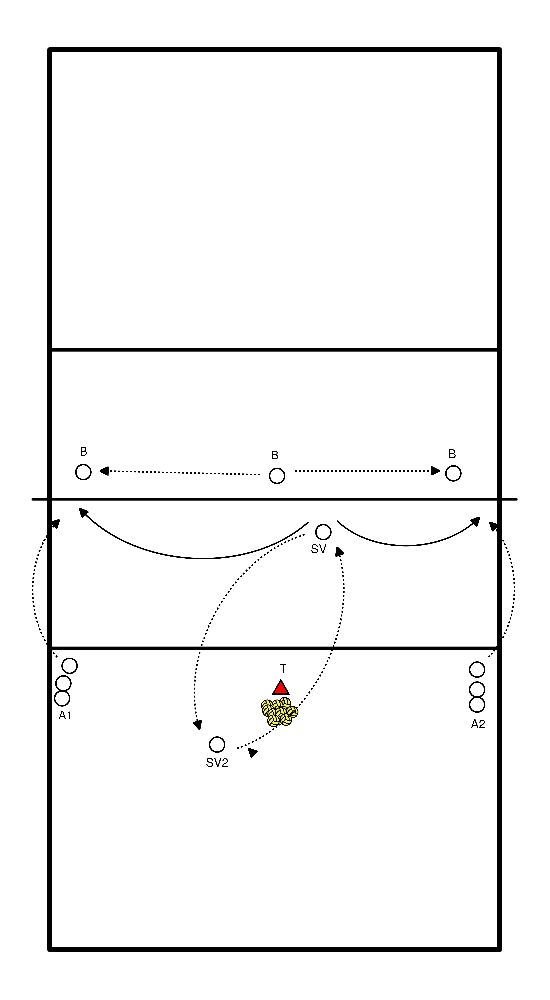Volleyball drills for technique block / net defense
- 2 players, 1 ball
- net lower
- 1 player plays the ball soft and short over the net
- 1 player blocks
- hands over the net -> ball down
- 1 player is at the service of the blocker.
- It is about the success of the blocker (possibly lower the net for smaller players).
* You divide your players into 2 pairs.
* Each pair 1 ball
One of the pair is standing at the net to make a block.
The other player stands on the opposite side of the net with a ball. The player stands on the three-meter line and throws the ball just over the net.
The player standing on the three-meter line throws the ball just over the net.
* 20 balls and then switch tasks.
* Divide the team into two rows.
The rows are formed next to each other on the 3 meter line.
The first one of each row walks to the net and blocks as synchronously as possible with the first one of the other row.
* The two each go the other outside and join there to make a block with the player waiting there.
The player on the outside joins the back of the line.
The player who came from the middle positions positions himself on the outside and makes a block with the next player from the middle.
* Divide the team over the net on both sides.
The captain blocks from his position.
Before the captain goes back down, the person to the left of the captain makes a block.
In this way, each player on the left will make a block and you will get a wave effect.
1 player with ball in the center of the field
Player 2 stat ready to block
- Player 1 hits the ball and throws it high and such that it falls into the circle (center of the field)
- Player 2 makes a block jump and immediately after that he defends the thrown ball of player 1.

Goal : develop game insight for attack
- A1 plays the ball to SV.
- Sv set-up to pos.4 where A attacks.
- At the moment A attacks, A1 plays a second ball to SV.
- B & B1 take care of the block. (B1 always starts from pos.3), L defense.
- Second attack of A. place ball. L stands on a mat. Where L is not standing should be played to.
We try to grow into a match form. Block gets points when attack can be stopped. Attack when scored or ball on the mat. Defender when defended.

Purpose: peripheral view.
- C plays the ball to L.
- L plays the ball to pos 3/2 --> SV2
- Meanwhile, B3 moves to pos 2 or 4. (draw. to 2)
- SV2 setup to the pos. where there is only one block.
- C goes blocking
- A attacks.
Meanwhile:
- T plays ball to SV1
- SV1 setup to attacker where there are two blocks.
Extension : field defense.

Goal of the exercise is, the playmaker must try to make sure that on the other side of the net a double block can not be formed.
- T plays the balls at a high pace towards pos. 3.
- SV walks in and gives set-up for -or backwards to fool the block.
- B tries to come to a drawbar block on attack.
- SV passes around T after set-up.
- SV1 & 2 switch positions after each set-up.
Expansion :
- Add field defense. (Liberos)
- B's play ball high back over to attacker passing towards pos 3/2
- Exercise starts again from pass attacker.

- Split jump lunge is the volleyball exercise that offers a great way of strengthening glutes, quads and hips.
- So, this exercise will have a huge positive impact on your vertical jump.
- It’s worth noting that this exercise requires some balance as well as a lot of strength from a lower body.
- It’s very important for you to take the right position before starting a split jump lunge.
- You should keep your knee directly over your foot.
- On the other hand, your knee shouldn’t go over your toe.
- Then, you need to drop down into the lunge.
- Now, it’s time for you to push both your feet simultaneously and switch legs.
- Lastly, you should gently land on the floor keeping your feet wide.
- You should also raise the opposite arm of your front leg while landing.
Agreements about blocking
- Always 2 blockers on the outside
- Block left (outside) arm's length of the antenna (diagonal blocking)
- Block right (diagonal) at the antenna (straight block)
- This makes sure that position 1 (playmaker) can always be blocked, so no hard attack on position 1 is possible.
- Block middle by 1 person, block on the ball.
- The players are in a line at position 1.
- The first makes a jump service (without ball), then runs diagonally to the net (position 4).
- Here, he/she makes a block, shuffles backwards to the 3m line, and attacks.
- Then, he/she shuffles to the middle and does the same.
- Keeps shuffling to the right and does the same here.
- Makes a dive to position 1.
GOAL
Feet work for block
ORGANIZATION
Two (equal) players are across each other at the net.
EXECUTION
- A player makes a low block movement, after landing a shuffle, steps to the right and takes the ball from across the net where the other player is holding the ball. Shuffle back and transfer the ball under the net to the other player.
- Change every 5 balls
- Each 2 series of 5 taking ball over the net
- A player makes a low block movement, at landing weight more on left leg. Make a step to the right, join legs, and take the ball from other side net where the other player holds the ball up.
- Change every 5 balls
- Each 2 series of 5 taking ball over the net
It is not about the speed but about the movement and the right foot work!!







